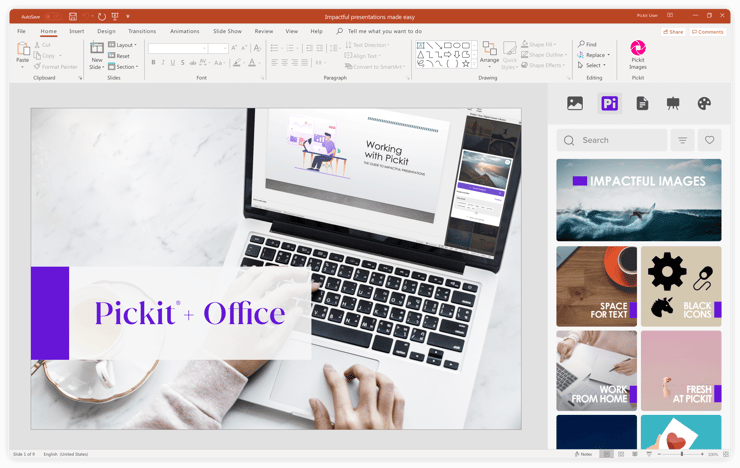Common presentation fails you can easily avoid
A good presentation can mean the difference between winning the pitch or losing the deal. Between securing the budget you need for next year or dealing with cutbacks. Between educating, informing and inspiring people or putting them to sleep.
In other words, the humble PowerPoint presentation is not to be taken lightly. With enough practice and the right tools, a simple 10-slide deck can create life-changing moments for you, your business and your audience. However, it's surprisingly common in this day and age to still be seriously underwhelmed by most presentations–even those created by extremely smart people working at very successful organizations.
In this practical post, we cover the 5 common presentation fails you can easily avoid with the help of a few simple tips and access to the right images.
1. Starting the presentation in PowerPoint

This might seem like a strange one since we're big fans of PowerPoint, but as much as we love what it can do for you on stage or in the boardroom, it's a bad place to start the creative process. Copy-pasting an old deck and trying to adapt it on the fly without putting any real thought into what you're actually trying to achieve isn't the way to tackle any talk, pitch, or report.
Start on paper and figure out what you want to say before getting distracted by templates, fonts, images and layouts. That way, you can determine what kind of deck will serve you best based on what you're actually trying to achieve.
Not knowing the point of a presentation is a surprisingly common problem. And if the presenter doesn't have a clear goal in mind, how on earth will the audience know what they're expected to do with what they've just heard?!
Here are four things to put on paper before moving to Powerpoint:
- Why are you presenting? What's the point?
- What do you want people to do afterwards?
- How can you best get that message across?
- Which slide elements will best support your message?
When you're clear, it'll be easier to figure out what you need to include and exclude. Anything that's not serving your message and end goal has to go.
2. Not knowing how to structure a presentation

Good books, movies and presentations have something in common. Their structure. Without certain key elements and a good structure, they just don't work.
Consider things like the audience, the objective of the message, and what takeaways you want to leave them with at the end; but also consider structure. Are you able to introduce the theme in an interesting way that will hook the audience without giving away your main point until a little later? Are there other ways you can build some healthy tension and curiosity by telling a story first to draw people in, introducing your primary message or insight a little later on? Can you use questions and interactive elements to engage the audience?
Here's a formula that's worked well for me:
- The Intro
- About 5-10% of the total length of the presentation
- Focus on hooking the audience with a shared problem, statement or story
- Talk about something your audience is interested in
- Don't waste it on too many boring details about yourself
- Try starting with a story
- The Main Message
- Spend about 85% of your time here
- Try dividing it into 3 points, insights or pieces of information
- Make it a journey–don't just go round in circles
- The Outro
- Save about 5% of your time for your takeaways
- Use the time to repeat your primary point or message
- Give people something clear to do or remember
Sometimes the most successful path isn't the most direct and predictable route from A to B. There are times when the scenic route isn't just more appealing, but more effective when it comes to helping people come along on the journey and stay alert all the way to the end.
3. Using predictable images that turn people off

You can be an expert on your subject matter, but if you don't know which images to use to frame your topic, you'll be struggling to keep people engaged.
Ask yourself if there's a more interesting and unique way to illustrate things rather than always relying on the same images everyone's seen before. Too many bullseyes, handshakes and staged office shots of men in suits won't do you any favors if you want people to stay switched on.
Read more: How to simplify your workflow in Microsoft PowerPoint
4. Spending too much time finding the right images
When you're creating a presentation, you want to be spending your time and crafting a killer message and massaging your content so it's just right. Oftentimes what happens is we spend that time looking for images instead.
5. Using old company visuals that are off brand

So you've ticked all the boxes above, but you still need to put the company stamp on it. Now's not the time to undo all your hard work putting your amazing deck together by using the old company logo or sticking it on the wrong color background! Or worse still, stretching it out of shape without constraining proportions.
So, what's the solution?

What if I told you that there's a solution to this right at your fingertips within PowerPoint? At Pickit, we want to make your life at work easier, give you full control and a complete overview of what services are accessed and used by your team. Not to mention the peace of mind of using an image service that is always 100% legally compliant.
Quite simply, Pickit is the world's simplest digital asset management system. Built for the modern workplace, it's the easiest way to organize, optimize, and share your company images, documents, templates, and brand assets in Microsoft 365 and on the web. Book a demo today and get started with a free trial in a matter of minutes.
